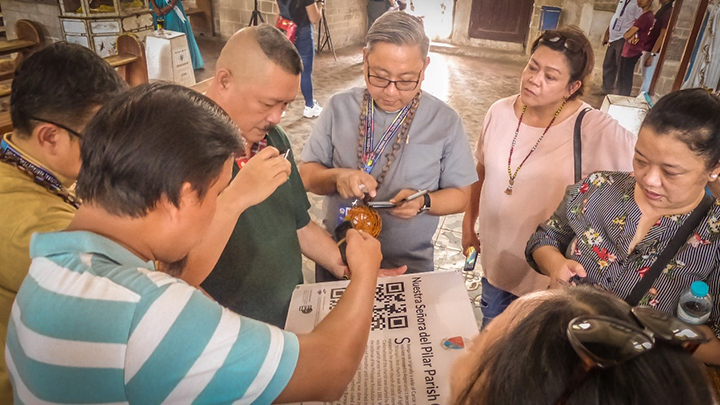In one of the centuries-old stone churches in Cebu, the parish priest once had the images of the Virgin Mary and three archangels repainted in the same color as the retablo where they were enshrined, gold. The elaborately carved wooden structure with sculptures that served as backdrop to the main altar of the 18th-century St. Michael the Archangel Parish Church in Argao retained its monochromatic appearance for a decade.
When participants of the 11th Biennial National Convention of Church Cultural Heritage Workers visited the church recently, however, the retablo of the Baroque Rococo church had been restored to its original colors, notably the sky blue of Mary’s mantle and the maroon of St. Michael’s cloak.
Thanks to new technology, the National Historical Commission of the Philippines (NHCP) was able to reverse the damage done to the Argao Church retablo, said Fr. Brian Brigoli, head of the Cebu Archdiocesan Commission on the Cultural Heritage of the Church.
“The statues of the Virgin Mary and the archangels St. Michael, St. Gabriel, and St. Raphael are no longer golden. The technology that allowed NHCP to undo the damage became available about two years ago,” added Father Brigoli, who dated the repainting to a decade ago.
Documentation in restoration work
Documenting churches by taking pictures and saving copies to the cloud or in online services is important in conservation efforts. Whether the damage is caused by man or nature, as in typhoons and earthquakes, restoration is easier when there are visual records, said architect Maxwell Espina of the Cebu Archdiocesan Commission for the Cultural Property of the Church (ACCPC). Espina was one of the tour speakers.
Under the Digital Tourism program of PLDT wireless unit Smart Communications, in partnership with InnoPub Media, interactive markers have been placed on Spanish-era churches.
These markers have become a rich repository of materials on Church cultural properties and could help spread awareness on Church history and message, said Father Brigoli, who oversaw the turnover of interactive markers to the parishes of Argao, Dalaguete, Sibonga, Carcar, and Boljoon.
“We can’t go into conservation unless we have proper understanding of heritage, its mandate, purpose, meaning and value. These serve as the very foundation of our efforts to restore and safeguard our heritage churches,” he said.

At the Saints Peter and Paul Parish Church in Bantayan, where markers were recently placed, parish priest Joselito Danao said he noted more people scanning the QR code or tapping the NFC (near-field communication) sticker on the markers to learn more about the church. “I would say … we have achieved our purpose to provide easy access to information.”
A separate marker explains the visual spectacle on the ceiling of the church and depicts the collaboration of the Church, the local community, and a group of talented artists.
Awareness of Church heritage will help people connect the past with the present and hopefully strengthen their faith, Father Danao said.
Preserving Church cultural heritage
Smart aims to contribute to heritage conservation efforts by disseminating information and promoting awareness of the historic, cultural, and symbolic significance of distinguished churches all over the Philippines.
“Heritage awareness is important in conservation and management efforts. One of the most effective ways to instill respect for culture and heritage is to raise community awareness,” said Smart Visayas-Mindanao public affairs head Maria Jane Paredes. The convention is part of activities in the run-up to the quincentennial celebration of Christianity in the Philippines in 2021.
“As the bastion of Christianity in the Philippines, Cebu is home to some of the most prominent churches in the country. We Cebuanos and all Filipinos are blessed to have these historically significant churches within our reach, and we should do our best to help take care of these national treasures,” Paredes added.
Smart joined the convention from May 6-9 at Cebu Parklane International Hotel in support of Church conservation efforts. A tour of five Cebu southern churches was one of the activities of the five-day event, organized by the Catholic Bishops’ Conference of the Philippines’ Episcopal Commission for the Cultural Heritage of the Church, University of Santo Tomas Graduate School Center for Conservation of Cultural Property and Environment in the Tropics, and Archdiocese of Cebu. It is supported by the National Commission for Culture and the Arts (NCCA) and Defending Family Values Foundation.
Convention topics included talks on the Archdiocese of Cebu’s Church Heritage Work by Father Brigoli, Repair and Maintenance of Heritage Structures by Architect Melva Rodriguez-Java, a Piecing Together of Church Building History by Prof. Regalado Trota Jose of UST, Chemical Analysis of Historic Mortars from Different Spanish Colonial Fortifications in the Philippines by John Michael C. Cayme of UST, and Conservation of Sacred Structures in Nepal and India by Dr. Neel Kamal Chapagain of Ahmedabad University in India.
Liked this post? Follow SwirlingOverCoffee on Facebook, YouTube, and Instagram.

